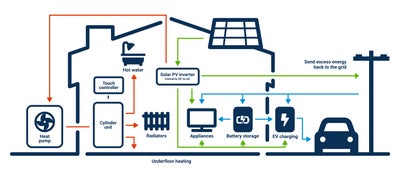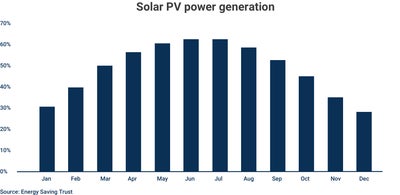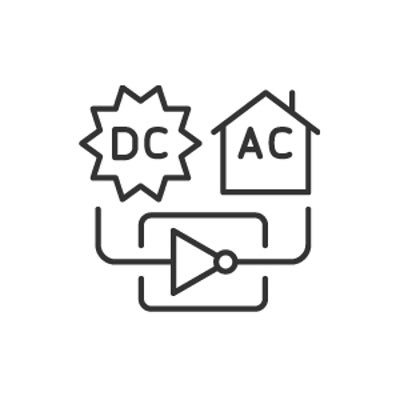
What is Solar PV and how does it work?
Typical solar panel systems contain around ten Panels and generate DC electricity. An inverter is installed to convert DC electricity to AC. This electricity can be used throughout your home, excess exported to the grid or stored in a storage battery to use at a later stage.


This graph is an example of the percentage of a household’s electricity demand which could be covered by solar PV generation throughout the year on weekdays. Please note that this is just an example for illustrative purposes and is based on assumptions which are described below.
The data shows seasonal variation in PV generation, with typically higher generation in summer. There could be some days with no cloud cover, whereby you can cover all your electrical energy requirements and sell electricity back to the grid.
The data takes into account average weather patterns such as cloud cover.
Important to note is as well as seasonal variation, there is also daily variation in PV generation. Evening usage of electrical appliances will use electricity from the grid (unless battery storage is being used for this purpose).
Solar PV generation varies based on several factors. The information provided in this graph is based on the following assumptions:
- The roof in this example has a 35 degree pitch and faces south: an unshaded, south-facing roof is ideal for maximum electrical output, though even homes with more east or west facing roofs could benefit. North facing roofs are less likely to be able to receive enough daylight to make a solar PV system viable.
- The roof in this example is unshaded and not using any optimising technology: finding an unshaded spot is best but if shading is unavoidable, you may be able to minimise the impact by using optimisers. If you don’t have shading, the use of optimisers is not necessary or beneficial, other than the increased monitoring opportunities they offer – they won’t generate more energy.
- The house in this example is located in Manchester: solar energy generation varies depending on location in the UK. But that’s not to say that it’s not worthwhile in more northern areas. In fact, there are a high number of installations of solar PV across the UK, including in the north of Scotland. To make sure solar PV is worth investing in, it’s more important to match the usage to your generation regardless of where you are in the country.
- The energy generated is from a 4 kWp (kilowatt peak) system. The average system size is around 3.5 kWp.
Above is the Savings (and simple payback) for a typical three-bedroom semi-detached home in Manchester. The more energy that is used during the day, the greater the savings. Savings can also include an income from the Smart Export Guarantee tariff if the household has one, and how often the household is at home using the energy.

Benefits of solar
Reduce cost of energy consumption
Sell excess energy to the grid and receive payments
Reduce your carbon footprint
Three main components

Different types of inverters
There are three different types of inverter:
String inverter: string inverters are the simplest and lowest cost option. The solar panels are wired together and connected by a single string inverter. If shading is likely on any panel, then an optimiser is recommended to preserve power output.
Hybrid inverter: a hybrid inverter is used when energy storage with a battery is required. If shading is likely on any panels, then an optimiser is recommended to preserve power output.
Micro inverter: a micro inverter is a device that connects to a single solar panel and converts DC into AC. A key distinctive feature of micro inverters is that on the occasions where there is single panel malfunctioning or faulty wiring issue, the faulty panel is isolated by the attached micro inverter without interrupting the power generation in the rest of the array. A micro inverter may be used when energy storage with a battery is required. Does not require additional optimisers, even when there is shading likely on any panel.

The average domestic solar PV system is 3.5kWp and costs around £7,000. A Smart Export Guarantee tariff will pay for any exported electricity your home doesn’t use. Other export tariffs are available. Savings above include export payments from a Smart Export Guarantee tariff.
Installation checklist
- Solar PV should be installed by a Qualified Registered Electrician who is MCS certified and HIES accredited
- A survey of the home will be required before installation
- Additional permission may be required by the local planning office. Restrictions may apply




